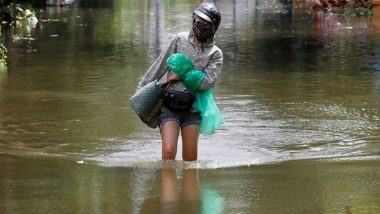Sumas (US), Nov 18: Residents of this small U.S. city along the Canadian border were assessing damage from flooding that hit an estimated three quarters of homes, as Washington state and British Columbia tried to dry out from an intense, days-long rain storm that cut off key roadways and forced hundreds of evacuations.
Skies were sunny Wednesday morning in the area around Sumas, Washington, where about 500 rescues and evacuations were reported.
“We're looking at going door-to-door, as waters go down in different parts of town,” Sumas Mayor Kevin Christensen told The Seattle Times. “Half is on dry ground, half has water.”
The soaking by a so-called atmospheric river that dumped torrents rain on the Pacific Northwest and British Columbia from Saturday through Monday reminded people of western Washington's record, severe flooding in November 1990 when two people died and there were more than 2,000 evacuations.
Also Read | Afghanistan: Taliban Arrest Man for Selling At Least 130 Women in Northern Jawzian Province.
While the weather was improving, the situation remained dire in British Columbia, where the Canadian government was sending in the military to help out with floods and mudslides that destroyed parts of several major highways.
Immediately across the border from Sumas, residents of a low-lying area of Abbotsford, British Columbia, have been warned they face a significant risk to life and must evacuate to avoid rising water levels.
Mayor Henry Braun said Wednesday that conditions were bad overnight because a key pumping station was in danger of being overwhelmed. He said crews spent Tuesday night sandbagging around the station and things were “holding steady.”
“I'm feeling much better today than last night,” Braun said, although he cautioned the danger had not passed.
Fast-rising water levels on the Sumas River in Washington state on Tuesday overwhelmed rescuers in Abbotsford, where 1,100 homes were evacuated.
Those residents joined thousands of others in the province who were forced from their homes by floods or landslides starting Sunday night.
Braun said Tuesday that impassable highways were creating havoc as authorities tried to get people to evacuation sites.
On Facebook, the City of Sumas said Wednesday that water levels were continuing to drop and it looked like the community wouldn't be affected by the situation in Abbotsford. It said crews were working hard to clear roads and return power to parts of town still without.
“These families and businesses need our prayers and support as we start the process of cleanup and rebuilding over the next few days,” the city said in another Facebook post.
Across the border, the body of a woman was recovered from a landslide near the small community of Lillooet, British Columbia,. Royal Canadian Mounted Police said at least two other people were reported missing.
Southwest of Sumas, Washington, a 59-year-old man from Everson identified by police Tuesday as Jose Garcia remained missing after his truck was swept into a flooded field and he had been clinging to a tree.
In the city Ferndale, also southwest of Sumas, officials on Tuesday urged people in homes and businesses to evacuate in an area near the rising Nooksack River. Bystanders near the town's main street rescued a man Tuesday who mistakenly drove into floodwaters. The half-dozen people waded into waters up to their chests and pushed the floating car to drier ground.
The rains were caused by an atmospheric river — a huge plume of moisture extending over the Pacific and into Washington, Oregon and British Columbia.
About 5.57 inches (14.14 centimeters) of rain fell at Bellingham International Airport from Saturday through Monday, Nov. 15. The normal monthly rain total is 5.2 inches (13.2 centimeters) for November, according to National Weather Service data.
Washington Gov. Jay Inslee on Monday declared a severe weather state of emergency in 14 counties.
It was the second major widespread flood event in the northwest part of Washington state in less than two years, and climate change is fuelling more powerful and frequent severe weather, Whatcom County officials told the Bellingham Herald.
(The above story is verified and authored by Press Trust of India (PTI) staff. PTI, India’s premier news agency, employs more than 400 journalists and 500 stringers to cover almost every district and small town in India.. The views appearing in the above post do not reflect the opinions of LatestLY)













 Quickly
Quickly












